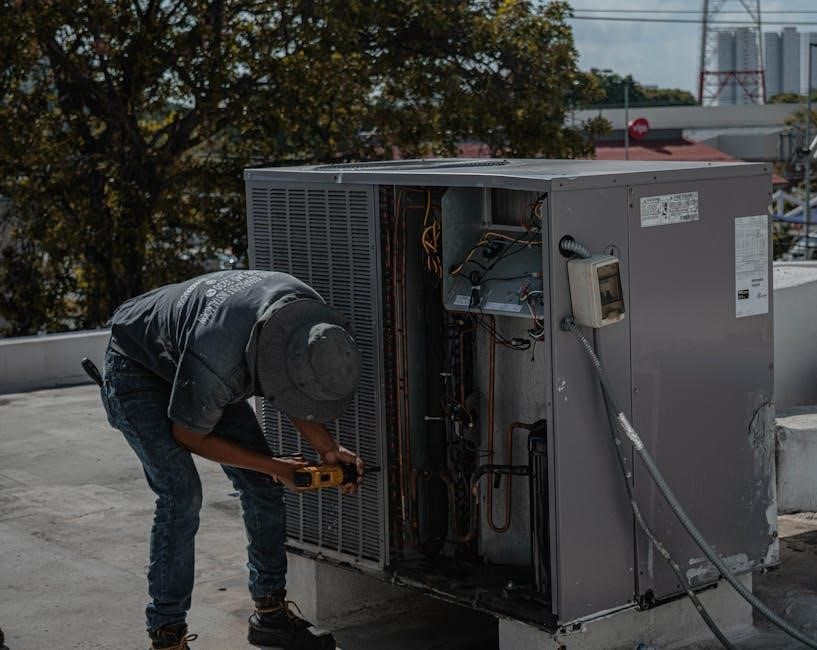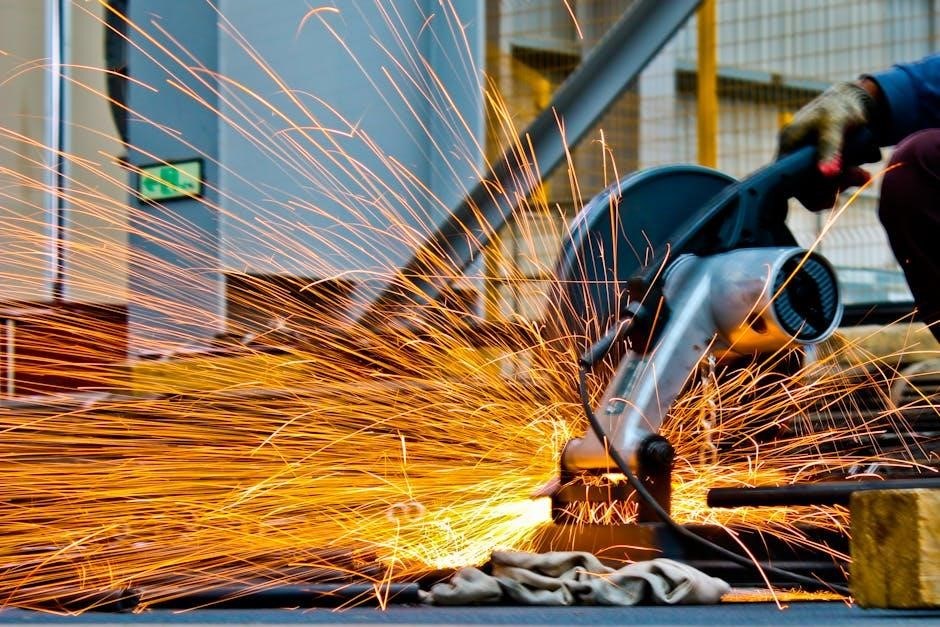Welcome to the Mitsubishi Industrial Air Conditioner Manual, your comprehensive guide to understanding and optimizing your unit’s performance. This manual is designed to help you navigate installation, operation, and maintenance, ensuring efficiency and safety. Discover key features, benefits, and troubleshooting tips to maximize your system’s potential and longevity. Proper use of this manual guarantees optimal functionality and compliance with industry standards.
1.1 Importance of the Manual for Optimal Performance
The Mitsubishi Industrial Air Conditioner Manual is essential for achieving optimal performance and longevity of your unit. It provides detailed instructions for installation, operation, and maintenance, ensuring compliance with safety standards and manufacturer recommendations. By following the manual, you can avoid common issues, troubleshoot effectively, and maximize energy efficiency. Proper adherence ensures your system operates safely and efficiently, maintaining comfort and reducing operational costs over time.
1.2 Key Features of Mitsubishi Industrial Air Conditioners
Mitsubishi Industrial Air Conditioners are renowned for their advanced features, including Hyper Heat systems for efficient heating in extreme cold, zoning capabilities for precise temperature control, and variable speed compressors for enhanced comfort and energy savings. These units also feature high-efficiency ratings, quiet operation, and durable construction, ensuring reliable performance for industrial applications. Their modular designs allow for flexibility in installation, making them ideal for diverse commercial and industrial settings.
1.3 Benefits of Using Mitsubishi Industrial Air Conditioners
Mitsubishi Industrial Air Conditioners offer exceptional energy efficiency, reducing operational costs while maintaining optimal temperatures. Their reliable performance and durable construction ensure long-term savings and minimal downtime. Advanced features like Hyper Heat systems provide efficient heating in extreme conditions, while zoning capabilities allow precise temperature control. These units also boast quiet operation and environmental compliance, making them a top choice for industrial applications. Mitsubishi’s innovative technology ensures enhanced comfort and reduced energy consumption, delivering superior value for industrial spaces.

Understanding the Mitsubishi Industrial Air Conditioner Manual
This section provides a detailed overview of the manual, including how to locate and download it, read model and serial numbers, and navigate its contents effectively for specific instructions.
2.1 How to Locate and Download the Manual
To locate and download the Mitsubishi Industrial Air Conditioner Manual, visit the official Mitsubishi website or authorized dealer portals. Use the model and serial number found on the unit’s nameplate to search the database. Ensure the manual is downloaded from a trusted source to avoid incorrect or outdated information. If unavailable online, contact Mitsubishi customer support directly for assistance.
2.2 Reading the Model and Serial Numbers
Locate the model and serial numbers on the unit’s nameplate, typically found on the outdoor or indoor unit. These numbers are essential for downloading the correct manual and ensuring compatibility. The model number identifies the specific product line, while the serial number provides unique unit details. Accurate reading ensures you access the right instructions and specifications for your Mitsubishi Industrial Air Conditioner, avoiding misinformation or incorrect parts.
2.3 Navigating the Manual for Specific Instructions
Navigate the Mitsubishi Industrial Air Conditioner manual by using the table of contents or index to locate specific sections. Each chapter is organized by topic, such as installation, operation, and maintenance. Use the search function in digital versions to quickly find keywords like “troubleshooting” or “timer settings.” Pay attention to highlighted sections and notes for critical information. Familiarize yourself with the manual’s structure to efficiently access the guidance you need for optimal performance and troubleshooting.
Installation and Setup Guidelines
Ensure proper installation by following the pre-installation checklist, step-by-step process, and post-installation checks. Verify compliance with safety standards, unit placement, and secure connections. Confirm system performance and refer to the manual for detailed guidance.
3.1 Pre-Installation Checklist
Before installation, ensure the site is prepared with proper space and drainage. Verify electrical compatibility, wiring connections, and refrigerant handling. Check for obstructions and ensure safety guidelines are met. Confirm all components are included and undamaged. Review local regulations and consult the manual for specific requirements. Ensure proper ventilation and structural integrity for unit placement. Plan for waste disposal and necessary tools. Verify thermostat wiring and compatibility with the system. Ensure all safety precautions are understood and followed.
3.2 Step-by-Step Installation Process
Begin by unpacking and inspecting the unit for damage. Mount the indoor unit securely, ensuring proper drainage and ventilation. Install the outdoor unit on a level surface, away from obstructions. Connect electrical wires according to the manual, verifying compatibility and safety. Link the refrigerant lines, ensuring tight connections to prevent leaks. Activate the system and test all functions to confirm proper operation. Follow safety guidelines and manufacturer instructions for a successful setup.
3.3 Post-Installation Checks and Tests
After installation, inspect all connections for leaks and ensure proper sealing. Test the system by running a full cycle to verify cooling and heating performance. Check thermostat operation and airflow distribution across vents. Verify that all safety features, such as emergency shutdown, are functioning correctly. Ensure compliance with local electrical and safety standards. Refer to the manual for specific testing procedures and guidelines to confirm optimal system operation.
Operating and Controlling the Air Conditioner
Learn how to operate your Mitsubishi Industrial Air Conditioner efficiently using the remote control, understanding basic functions, and managing scheduling and timer settings for optimal performance.
4.1 Using the Remote Control Effectively
Your Mitsubishi Industrial Air Conditioner remote offers precise control over temperature, fan speed, and operation modes. Familiarize yourself with buttons for power, mode selection, and temperature adjustment. Use the timer function to schedule operations, optimizing energy use. Explore advanced features like energy-saving modes to enhance efficiency. Regularly check battery levels to ensure uninterrupted control. Refer to the manual for detailed button functions and customization options to tailor your comfort experience.

4.2 Basic Functions and Modes of Operation
Your Mitsubishi Industrial Air Conditioner offers multiple operating modes, including cooling, heating, fan-only, and dehumidification. These modes allow you to tailor the system to your specific needs. The cooling mode lowers the temperature, while heating provides warmth. Fan-only circulates air without cooling or heating, and dehumidification reduces moisture levels. Each mode is designed for optimal comfort and energy efficiency. Refer to the manual for detailed instructions on selecting and adjusting these modes effectively.
4.3 Scheduling and Timer Settings
The Mitsubishi Industrial Air Conditioner allows you to set specific schedules and timer settings for optimal energy management. Use the timer to program start and stop times, ensuring the unit operates only when needed. This feature helps reduce unnecessary energy consumption and maintains consistent temperatures. Refer to the manual for detailed instructions on setting schedules and timers to maximize efficiency and comfort. Proper use of these settings can significantly enhance energy savings and system performance.

Maintenance and Troubleshooting
Regular filter cleaning and condenser coil checks ensure optimal performance. Address common issues like leaks or error codes promptly. Refer to the manual for troubleshooting guides. Schedule professional inspections for complex problems to prevent breakdowns and extend the unit’s lifespan. Proper maintenance ensures efficiency, reliability, and safety.
5.1 Routine Maintenance Tasks
Regular maintenance is crucial for optimal performance. Clean or replace air filters monthly to ensure airflow. Check and clean condenser coils quarterly to prevent dust buildup. Inspect drain pipes for blockages and ensure proper drainage. Verify refrigerant levels and inspect electrical connections annually. Schedule professional servicing every 12 months to maintain efficiency and prevent potential issues. Consistent upkeep extends lifespan and ensures reliable operation.
5.2 Common Issues and Troubleshooting Tips
Common issues include the unit not turning on, refrigerant leaks, or excessive noise. For power issues, check circuit breakers and thermostat settings. Inspect refrigerant lines for damage and tighten connections if necessary. Noise problems may require balancing fans or adjusting installation. Always refer to the manual for specific troubleshooting steps. If issues persist, contact a certified technician to avoid further damage and ensure safe operation.
5.3 When to Contact a Professional
If you encounter complex issues like refrigerant leaks, electrical malfunctions, or internal component failures, it’s best to contact a professional. Additionally, if repairs require specialized tools or knowledge beyond basic troubleshooting, seek expert assistance. Always consult a Mitsubishi-authorized technician for warranty-related issues or when dealing with high-voltage components to ensure safety and compliance with manufacturer guidelines. This ensures proper repairs and maintains system performance and longevity.
Advanced Features of Mitsubishi Industrial Air Conditioners
Mitsubishi industrial air conditioners feature cutting-edge technologies like Hyper Heat systems, zoning capabilities, and variable speed compressors. These advanced features enhance performance, efficiency, and comfort, making them ideal for industrial settings.
6.1 Hyper Heat Systems: Facts and Myths
Mitsubishi’s Hyper Heat systems are designed to provide efficient heating in extreme cold climates. While myths suggest they may not perform well in freezing temperatures, these systems are engineered to maintain consistent heat even at low outdoor temperatures. They offer high energy efficiency and reliability, making them a practical choice for industrial applications requiring robust heating solutions.
6.2 Zoning Systems: Benefits and Considerations
Zoning systems allow precise temperature control across different areas, enhancing comfort and energy efficiency. They are ideal for industrial spaces with varying cooling needs. Benefits include reduced energy waste and tailored climate control. However, considerations like higher installation costs, system complexity, and the need for proper balancing must be addressed. When executed correctly, zoning systems provide exceptional performance and long-term savings, making them a valuable addition to industrial air conditioning setups.
6.3 Variable Speed Systems for Enhanced Comfort
Variable speed systems in Mitsubishi industrial air conditioners offer enhanced comfort by adjusting fan speed to match cooling demands. This reduces noise levels and energy consumption while maintaining consistent temperatures. These systems provide precise control, minimizing operational fluctuations. However, some users note limited speed options and the need for proper installation to maximize benefits. Despite this, variable speed systems remain a significant advancement in air conditioning technology, improving overall efficiency and user satisfaction.

Energy Efficiency and Cost Savings
Mitsubishi industrial air conditioners prioritize energy efficiency, featuring high-efficiency models that reduce power consumption. Smart technologies optimize performance, lowering utility bills and providing long-term financial benefits while maintaining comfort.
7.1 Understanding Energy Ratings and Efficiency
Mitsubishi industrial air conditioners are designed with energy efficiency in mind, offering high SEER (Seasonal Energy Efficiency Ratio) and EER (Energy Efficiency Ratio) ratings. These ratings measure cooling efficiency and energy consumption. Higher ratings indicate better performance and lower utility bills. Mitsubishi systems often feature advanced technologies like variable-speed compressors and smart sensors to optimize energy use. Understanding these ratings helps you choose the right model for your needs, ensuring both cost savings and environmental benefits. Always refer to the manual for specific energy details and recommendations.
7.2 Tips for Reducing Energy Consumption
To minimize energy use, adjust temperature settings to avoid overcooling and ensure proper installation for optimal airflow. Regularly clean filters and check refrigerant levels to maintain efficiency. Use timer settings to operate the unit only when needed, and optimize thermostat settings for consistent comfort. Consider upgrading to Mitsubishi’s variable-speed systems, which adapt to demand, reducing unnecessary energy consumption. Proper maintenance ensures long-term efficiency and cost savings.
7.3 Long-Term Cost Benefits of Proper Maintenance
Regular maintenance significantly reduces long-term costs by preventing costly repairs and extending equipment lifespan. Cleaning filters and checking refrigerant levels ensures optimal performance, lowering energy bills. Proper care reduces the likelihood of major issues, minimizing downtime and repair expenses; Investing in routine maintenance also enhances efficiency, reducing overall operational costs and ensuring your Mitsubishi air conditioner delivers consistent performance for years to come.
Safety Precautions and Compliance
Adhering to safety guidelines and handling refrigerants safely ensures compliance with local and international standards, guaranteeing safe, efficient operation and minimizing environmental impact.
8.1 Safety Guidelines for Installation and Use
- Always follow the manufacturer’s instructions for installation and operation to ensure safety and efficiency.
- Avoid applying power to terminals labeled “N” to prevent short circuits and potential damage.
- Handle refrigerants safely, adhering to environmental and safety regulations to minimize risks.
- Conduct thorough leak checks post-installation to ensure system integrity and performance.
- Consult professionals for repairs requiring additional refrigerant to maintain compliance and safety standards.
8.2 Compliance with Local Regulations and Standards
Ensure your Mitsubishi Industrial Air Conditioner complies with local laws and industry standards. Proper installation and use are crucial for safety and environmental compliance. Always refer to the manual for specific guidelines and adhere to regulations regarding refrigerant handling. Regularly update your system to meet evolving standards and consult professionals if unsure about compliance requirements. This ensures operational safety and avoids potential legal issues. Compliance is key to responsible ownership and optimal performance.
8.3 Handling Refrigerants Safely
Handling refrigerants in your Mitsubishi Industrial Air Conditioner requires strict adherence to safety protocols. Always wear protective gear, including gloves and goggles, when handling refrigerants. Use manufacturer-approved tools and follow guidelines to prevent leaks or exposure. Never overcharge the system, as this can lead to safety hazards. Ensure proper ventilation and comply with environmental regulations, such as those set by the EPA. Regularly inspect for leaks and use nitrogen for pressure testing when servicing. Always consult a professional if uncertain.
Following this manual ensures optimal performance and efficiency of your Mitsubishi Industrial Air Conditioner. Regular maintenance and proper use enhance comfort and longevity while ensuring safety and compliance.
9.1 Summary of Key Points
The Mitsubishi Industrial Air Conditioner Manual provides essential guidance for installation, operation, and maintenance. It emphasizes proper setup, energy efficiency, and safety protocols. Regular maintenance ensures optimal performance, while troubleshooting tips address common issues. Advanced features like zoning systems and Hyper Heat enhance comfort and efficiency. Adhering to the manual’s guidelines ensures compliance with industry standards, prolongs system lifespan, and maximizes overall satisfaction and operational reliability.
9.2 Final Tips for Maximizing Performance
For optimal performance, always refer to the manual for specific instructions tailored to your model. Regularly clean filters and inspect components to ensure efficiency. Utilize advanced features like timers and variable speed systems to enhance comfort and energy savings. Schedule professional maintenance annually and address issues promptly to prevent system strain. Follow safety guidelines and keep the unit well-maintained to enjoy reliable operation and extended lifespan.
9.3 Importance of Regular Updates and Support
Regular updates and support are crucial for maintaining peak performance and safety. Ensure your manual is up-to-date for the latest features and guidelines. Contact Mitsubishi directly for model-specific advice and troubleshooting. Manufacturer support offers tailored solutions, ensuring compliance with industry standards and extending system longevity. Stay informed about software updates and technical advancements to optimize your air conditioner’s efficiency and reliability over time.

